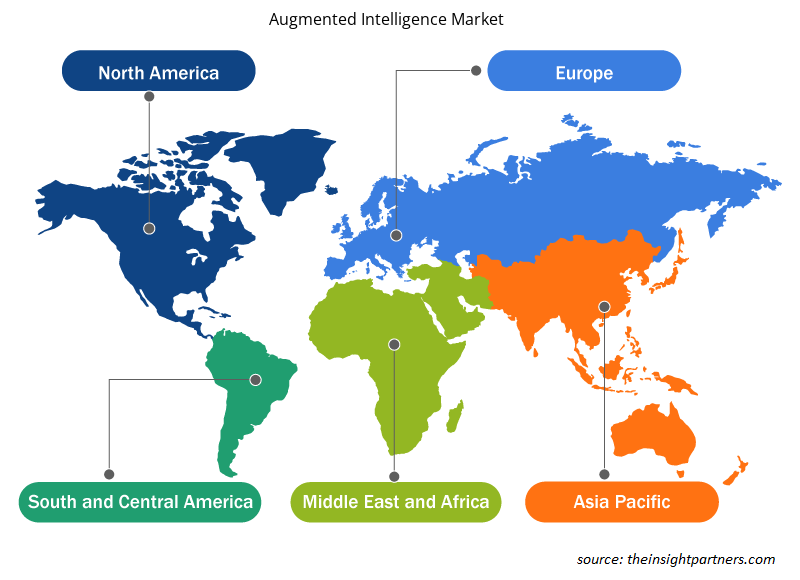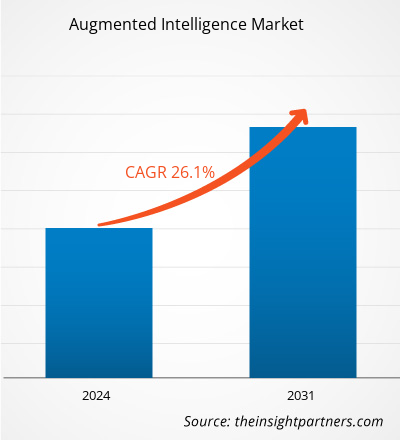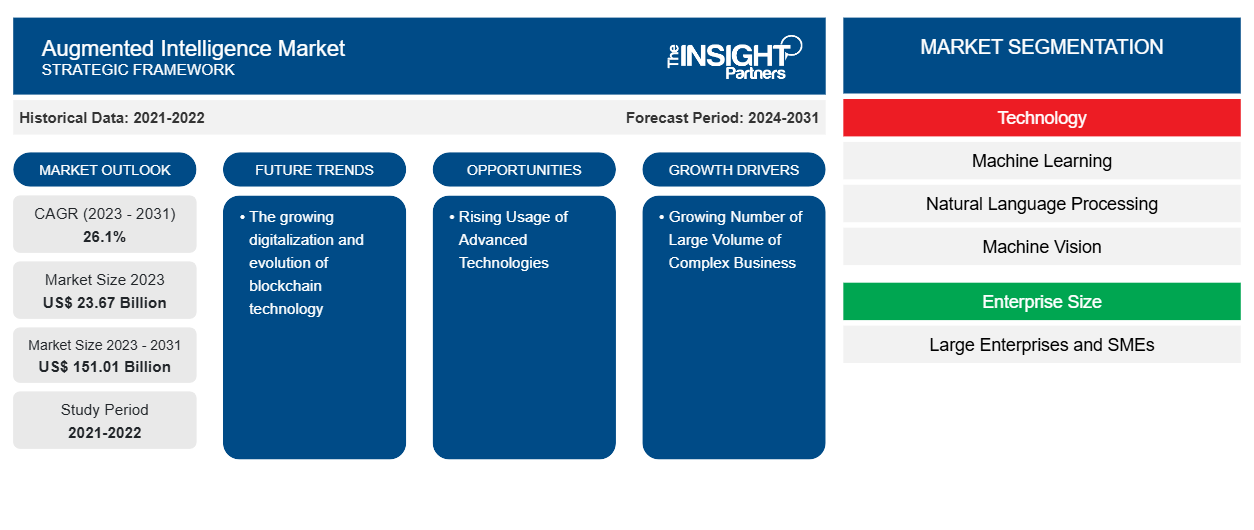增强智能市场规模预计将从 2023 年的 236.7 亿美元增至 2031 年的 1510.1 亿美元。预计 2023-2031 年市场复合年增长率将达到 26.1%。日益数字化和区块链技术的演进很可能仍是增强智能市场的一个关键趋势。
增强智能市场分析
由于大量复杂业务数据不断增长,以及 BFSI、IT 和电信以及零售和电子商务行业不断扩张,增强智能市场正在快速增长。由于中小企业越来越多地采用增强智能,市场正在稳步扩张。此外,企业越来越多地使用先进技术,越来越多地采用基于云的解决方案,为市场增长提供了有利可图的机会。
增强智能市场概况
增强智能是一种人工智能,专注于人工智能的辅助功能。此外,增强智能的创建是为了支持组织在商业和日常生活中做出更准确的数据驱动决策。此外,公司使用增强智能来提高员工绩效,并帮助组织了解员工需要改进的领域,从而推动市场发展。此外,增强智能是通过向企业提供预测分析来使用和优先处理大量安全数据的最有效技术。
定制此报告以满足您的需求
您可以免费定制任何报告,包括本报告的部分内容、国家级分析、Excel 数据包,以及为初创企业和大学提供优惠和折扣
-
获取此报告的关键市场趋势。这个免费样品将包括数据分析,从市场趋势到估计和预测。
增强智能市场驱动因素和机遇
日益增长的大量复杂业务数据正在推动市场
增强智能技术(例如机器学习和自然语言处理)对于数据分析越来越重要。增强智能可以分析公司内部存储的有组织、半结构化和非结构化数据源。随着行业的不断扩展和公司运营中数字技术的发展,未来几年创建的数据种类和数量预计将大幅增加。这增加了公司对增强智能解决方案的需求,以便有效、高效地管理其大量数据。然而,预计在预期的时间段内,复杂数据量的不断增长将推动增强智能市场的发展。
先进技术的使用日益增多——增强智能市场的机遇
人工智能、机器学习和自然语言处理等先进技术的使用日益增多,为预测期内的市场增长创造了机会。许多行业,如 IT 和电信、零售和电子商务、BFSI、医疗保健等,都在生成大量数据,需要先进的技术来实时分析这些数据,这增加了对增强智能解决方案的需求。各行各业正在采用人工智能、机器学习和自然语言处理等新技术来分析大量数据,并实时做出有效决策。这些工具简化了从数据中提取见解的过程,从而增加了数据采用率并在市场中创造了机会。
增强智能市场报告细分分析
增强智能市场分析的关键部分包括技术、企业规模和最终用户
- 根据技术,增强智能市场分为机器学习、自然语言处理、机器视觉、情境感知计算等。机器学习领域在 2023 年占据了更大的市场份额。
- 就企业规模而言,市场分为大型企业和中小型企业。2023 年,中小型企业占据了更大的市场份额。
- 就终端用户而言,市场分为 IT 和电信、零售和电子商务、BFSI、医疗保健等。BFSI 部门在 2023 年占据了更大的市场份额。
增强智能市场份额(按地区)分析
增强智能市场报告的地理范围主要分为五个地区:北美、亚太、欧洲、中东和非洲、南美/南美和中美。
就收入而言,由于技术进步和主要参与者的存在,北美占据了增强智能市场的最大份额,这些参与者包括 IBM Corporation、Microsoft Corporation、TIBCO Software Inc.、Salesforce.com, Inc. 和 MicroStrategy Incorporated。这些参与者正在大力投资采用 AI、ML 和 NLP 等先进技术,并通过添加附加功能不断致力于开发这些技术。IT 和电信、BFSI、零售和电子商务、医疗保健等行业对基于云的增强智能的需求不断增长,预计将推动北美市场的发展。
增强智能市场区域洞察
Insight Partners 的分析师已详细解释了预测期内影响增强智能市场的区域趋势和因素。本节还讨论了北美、欧洲、亚太地区、中东和非洲以及南美和中美洲的增强智能市场细分和地理位置。

- 获取增强智能市场的区域特定数据
增强智能市场报告范围
| 报告属性 | 细节 |
|---|---|
| 2023 年的市场规模 | 236.7 亿美元 |
| 2031 年市场规模 | 1510.1亿美元 |
| 全球复合年增长率(2023 - 2031) | 26.1% |
| 史料 | 2021-2022 |
| 预测期 | 2024-2031 |
| 涵盖的领域 |
按技术分类
|
| 覆盖地区和国家 |
北美
|
| 市场领导者和主要公司简介 |
|
增强智能市场参与者密度:了解其对业务动态的影响
增强智能市场正在快速增长,这得益于终端用户需求的不断增长,而这些需求又源于消费者偏好的不断变化、技术进步以及对产品优势的认识不断提高等因素。随着需求的增加,企业正在扩大其产品范围,进行创新以满足消费者的需求,并利用新兴趋势,从而进一步推动市场增长。
市场参与者密度是指在特定市场或行业内运营的企业或公司的分布情况。它表明在给定市场空间中,相对于其规模或总市场价值,有多少竞争对手(市场参与者)存在。
在增强智能市场运营的主要公司有:
- IBM 公司
- 微软公司
- 思爱普
- TIBCO 软件公司
- Sisense 公司
- Salesforce.com 公司
免责声明:上面列出的公司没有按照任何特定顺序排列。

- 了解增强智能市场顶级关键参与者概况
增强智能市场新闻和最新发展
增强智能市场通过收集一手和二手研究后的定性和定量数据进行评估,其中包括重要的公司出版物、协会数据和数据库。以下是增强智能市场和策略的发展列表:
- 2023 年 9 月,甲骨文公司今天展示了 Oracle Analytics Cloud 中新的 AI 功能。新的自助式 AI 功能(包括生成式 AI 助手和增强分析)可帮助组织改善数据对决策的影响。(来源:甲骨文公司,新闻稿,2023 年)
增强智能市场报告覆盖范围和交付成果
“增强智能市场规模和预测(2021-2031)”报告对以下领域进行了详细的市场分析:
- 范围内涵盖的所有主要细分市场的全球、区域和国家层面的市场规模和预测
- 市场动态,如驱动因素、限制因素和关键机遇
- 未来的主要趋势
- 详细的 PEST/波特五力分析和 SWOT 分析
- 全球和区域市场分析涵盖关键市场趋势、主要参与者、法规和最新市场发展
- 行业格局和竞争分析,涵盖市场集中度、热点图分析、知名参与者和最新发展
- 详细的公司简介
- 历史分析(2 年)、基准年、预测(7 年)及复合年增长率
- PEST和SWOT分析
- 市场规模、价值/数量 - 全球、区域、国家
- 行业和竞争格局
- Excel 数据集
近期报告
客户评价
购买理由
- 明智的决策
- 了解市场动态
- 竞争分析
- 客户洞察
- 市场预测
- 风险规避
- 战略规划
- 投资论证
- 识别新兴市场
- 优化营销策略
- 提升运营效率
- 顺应监管趋势























 获取免费样品 - 增强智能市场
获取免费样品 - 增强智能市场